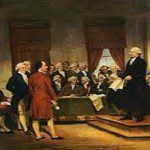![TheHobbit_Sdtk_Cover_1425px_300dpi1[1]](https://wp-media.patheos.com/blogs/sites/766/2015/07/TheHobbit_Sdtk_Cover_1425px_300dpi11-150x150.jpg) The day after Christmas a few years ago I went with my son to see Peter Jackson’s movie version of “The Hobbit,” Part One. I thoroughly enjoyed it, as I knew I would. I have been a Tolkienphile since my early teens, when The Hobbit was assigned by Mrs. Lord (a great name for a teacher) in my high school honors freshman English class. I loved it, and innocently said to Mrs. Lord “I like this—has this guy written anything else?” “As a matter of fact he has,” she replied, and turned me on to the wonders of The Lord of the Rings. It set off a love affair with J. R. R. Tolkien that has lasted for over forty years. Although I have strayed in the past few years, my first encounter with hobbits, dwarves, wizards, elves, orcs, and humans in Middle Earth caused me, going forward, to religiously read all four books once every three years. And I suspect that had Mrs. Lord not assigned The Hobbit, I might not have discovered Tolkien for many years after, if ever. It was one of my first examples of the joys of unexpected literary discoveries. It probably also explains why I have never read a word of the “Harry Potter” series”–the next generations Tolkien, I suppose.
The day after Christmas a few years ago I went with my son to see Peter Jackson’s movie version of “The Hobbit,” Part One. I thoroughly enjoyed it, as I knew I would. I have been a Tolkienphile since my early teens, when The Hobbit was assigned by Mrs. Lord (a great name for a teacher) in my high school honors freshman English class. I loved it, and innocently said to Mrs. Lord “I like this—has this guy written anything else?” “As a matter of fact he has,” she replied, and turned me on to the wonders of The Lord of the Rings. It set off a love affair with J. R. R. Tolkien that has lasted for over forty years. Although I have strayed in the past few years, my first encounter with hobbits, dwarves, wizards, elves, orcs, and humans in Middle Earth caused me, going forward, to religiously read all four books once every three years. And I suspect that had Mrs. Lord not assigned The Hobbit, I might not have discovered Tolkien for many years after, if ever. It was one of my first examples of the joys of unexpected literary discoveries. It probably also explains why I have never read a word of the “Harry Potter” series”–the next generations Tolkien, I suppose.
![muriel_barbery_personnalite_une[1]](http://freelancechristianitydotcom.files.wordpress.com/2013/07/muriel_barbery_personnalite_une1.jpg?w=116) I still enjoy the unforeseen pleasures of a new literary find. I recently reread one of my favorite novels, Muriel Barbery’s The Elegance of the Hedgehog and asked myself, upon finishing, a Mrs. Lord question: “I wonder if she’s written anything else?” Thanks to the wonders of Amazon, I found out in less than a minute that The Elegance of the Hedgehog is
I still enjoy the unforeseen pleasures of a new literary find. I recently reread one of my favorite novels, Muriel Barbery’s The Elegance of the Hedgehog and asked myself, upon finishing, a Mrs. Lord question: “I wonder if she’s written anything else?” Thanks to the wonders of Amazon, I found out in less than a minute that The Elegance of the Hedgehog is ![gourmet-rhapsody3[1]](https://freelancechristianitydotcom.files.wordpress.com/2013/07/gourmet-rhapsody31.jpg?w=192) Barbery’s second novel, that she studied philosophy at the Ecole Normale Superieure, and worked for a number of years in France as a philosophy teacher. I immediately ordered her first novel, Gourmet Rhapsody, to read during the break between semesters.
Barbery’s second novel, that she studied philosophy at the Ecole Normale Superieure, and worked for a number of years in France as a philosophy teacher. I immediately ordered her first novel, Gourmet Rhapsody, to read during the break between semesters.
It’s a short novel—a novella, really—that can easily be read in one day, especially if you have a cold and are resisting the siren call of work-related emails that you want to ignore until after New Year’s Day. In the midst of the story about a world-famous food critic who has been told that he has no more than two days to live, I read a sentence that has stuck with me over the past several months, even as the details of Barbery’s story drift away. “Life exists only by virtue of the osmosis between words and facts, where the former encase the latter in ceremonial dress.”
As I get older and become more able to put years of teaching experience and continuing personal transition and process into some semblance of context and perspective, I find myself placed often at the intersection of words and facts. Facts, the one damn thing after another that provide the stuff of reality, are naked and uninteresting until shaped by a context, energized by a story, or illuminated by narrative light. Yet we live in a world which often insists on just the facts. As the insurance investigators tell Pi Patel in Life of Pi, after listening to his story of survival involving a hyena, an orangutan, a tiger, and a carnivorous island, “for the purposes of our investigation we want to know what really happened.![The-Life-of-Pi[1]](https://freelancechristianitydotcom.files.wordpress.com/2013/07/the-life-of-pi1.jpg?w=199) We want a simpler story for our report, one the company can understand and that we can all believe.” But the notion that the truth is nothing more than facts properly assembled in appropriate order is itself the result of a particular narrative structure, a structure guaranteed to produce stagnation and mediocrity. “I know what you want,” Pi responds. “You want a story that won’t surprise you. That will confirm what you already know. That won’t make you see higher or further or differently. You want a flat story. An immobile story. You want dry, yeastless factuality.”
We want a simpler story for our report, one the company can understand and that we can all believe.” But the notion that the truth is nothing more than facts properly assembled in appropriate order is itself the result of a particular narrative structure, a structure guaranteed to produce stagnation and mediocrity. “I know what you want,” Pi responds. “You want a story that won’t surprise you. That will confirm what you already know. That won’t make you see higher or further or differently. You want a flat story. An immobile story. You want dry, yeastless factuality.”
If I have become convinced of anything in the twenty-five years that I have been teaching, it is that true learning only happens in the company of the desire to see higher, further, or differently. Accordingly, in the narrative of teaching and learning the atomic facts of reality are dressed up in various styles. Sometimes the dress is formal, sometimes casual, sometimes liturgical, and sometimes humorous. Occasionally learning happens best when facts are dressed as for a masquerade, deliberately seeking to conceal what is underneath. Almost never are facts served up naked, except to illustrate how dull and lifeless facts in the raw are, compared with what we might find in the word wardrobe to dress them in.
![story_iStock_000015344866Small[1]](https://freelancechristianitydotcom.files.wordpress.com/2013/07/story_istock_000015344866small11.jpg?w=150) Alasdair MacIntyre tells us that humans are story-telling animals, and as such we package the facts of our lives for ourselves and for each other in word-woven stories. But just as facts are, of themselves, incapable of conveying truth, so also it is often impossible for even the most skilled storyteller and communicator to encompass the highest truths with words. Human beings know this intuitively. Anyone who has ever tried to express the depths of real love finds that the reality always exceeds what can be expressed in words. As Reverend Ames says in Marilynne Robinson’s Gilead, “you must not judge what I know by what I find words for.” “Actions speak louder than words” is more than a truism or sound bite—it is an acknowledgement that the truth often must be shown rather than spoken or written about.
Alasdair MacIntyre tells us that humans are story-telling animals, and as such we package the facts of our lives for ourselves and for each other in word-woven stories. But just as facts are, of themselves, incapable of conveying truth, so also it is often impossible for even the most skilled storyteller and communicator to encompass the highest truths with words. Human beings know this intuitively. Anyone who has ever tried to express the depths of real love finds that the reality always exceeds what can be expressed in words. As Reverend Ames says in Marilynne Robinson’s Gilead, “you must not judge what I know by what I find words for.” “Actions speak louder than words” is more than a truism or sound bite—it is an acknowledgement that the truth often must be shown rather than spoken or written about.
The inadequacy of both naked facts and the words we dress them in is shockingly apparent when entering the realm of religious conviction. This is especially the case when the religion in question involves sacred texts, words that supposedly carry divine weight in some fashion or another. ![inerrancy_Gerstner[1]](https://freelancechristianitydotcom.files.wordpress.com/2013/07/inerrancy_gerstner1.gif?w=300) I am a product of a version of Christianity that treats the Bible as literal fact—this leads to shallowness, agnosticism, atheism, or at worst, rigid self-righteousness. When the “facts” are dressed up in ornamental dress, the product is stories, metaphors, doctrine, or dogma, depending on the style and the word-fashion designer. But embedded at the heart of the Christian narrative is a challenge both attractive and provocative. As with all of the greatest truths, the most dynamic aspects of the relationship between the human and the divine cannot be reduced to words.
I am a product of a version of Christianity that treats the Bible as literal fact—this leads to shallowness, agnosticism, atheism, or at worst, rigid self-righteousness. When the “facts” are dressed up in ornamental dress, the product is stories, metaphors, doctrine, or dogma, depending on the style and the word-fashion designer. But embedded at the heart of the Christian narrative is a challenge both attractive and provocative. As with all of the greatest truths, the most dynamic aspects of the relationship between the human and the divine cannot be reduced to words.
![ChristmasB-in-the-beg[1]](http://freelancechristianitydotcom.files.wordpress.com/2013/07/christmasb-in-the-beg1.gif?w=300) There is a reason why the writer of the Gospel of John begins by considering divine wordplay. “In the beginning was the Word, and the Word was with God, and the Word was God.” What sort of ceremonial dress is this? Alfred Korn puts it this way: “God is spirit, but at some point in history God became Word. This process of finding words for what cannot be expressed is incarnation.” As the Gospel writer tells us, “The Word became flesh and dwelt among us.” The depths of divine love cannot be exhausted by words, by speech, by texts, by facts dressed up in even the fanciest garb.
There is a reason why the writer of the Gospel of John begins by considering divine wordplay. “In the beginning was the Word, and the Word was with God, and the Word was God.” What sort of ceremonial dress is this? Alfred Korn puts it this way: “God is spirit, but at some point in history God became Word. This process of finding words for what cannot be expressed is incarnation.” As the Gospel writer tells us, “The Word became flesh and dwelt among us.” The depths of divine love cannot be exhausted by words, by speech, by texts, by facts dressed up in even the fanciest garb. ![www-St-Takla-org--Coptic-Saints-Saint-Athanasius-03-01[1]](https://freelancechristianitydotcom.files.wordpress.com/2013/07/www-st-takla-org-coptic-saints-saint-athanasius-03-011.jpg?w=105) These depths must be lived in and inhabited. And so the story goes—we are the continuing incarnation. As Saint Athanasius provocatively said, “God became human so that we might become God.” The Word continues to become flesh and live with us, because the Word is us. The life of faith is the life spent exploring what that amounts to and living it out.
These depths must be lived in and inhabited. And so the story goes—we are the continuing incarnation. As Saint Athanasius provocatively said, “God became human so that we might become God.” The Word continues to become flesh and live with us, because the Word is us. The life of faith is the life spent exploring what that amounts to and living it out.
PS: My new book, Freelance Christianity, has just been published by Cascade Books! If you like my blog, you’ll love my book! For a full description of the book, as well as reviews and endorsements (including one from NY Times bestselling author Kathleen Norris), click on the “Publications” tab at the top of my blog. Thanks!


![TheHobbit_Sdtk_Cover_1425px_300dpi1[1]](https://wp-media.patheos.com/blogs/sites/766/2013/07/thehobbit_sdtk_cover_1425px_300dpi11.jpg?w=300)










